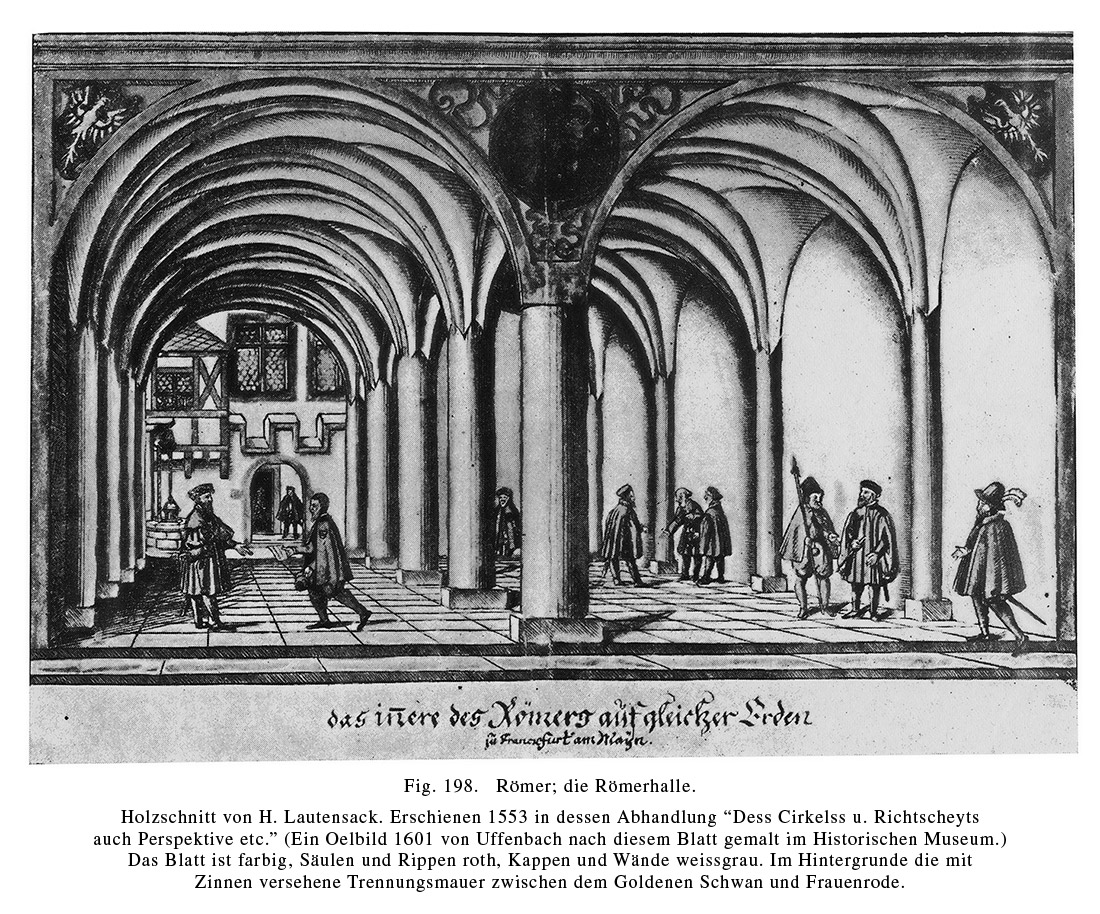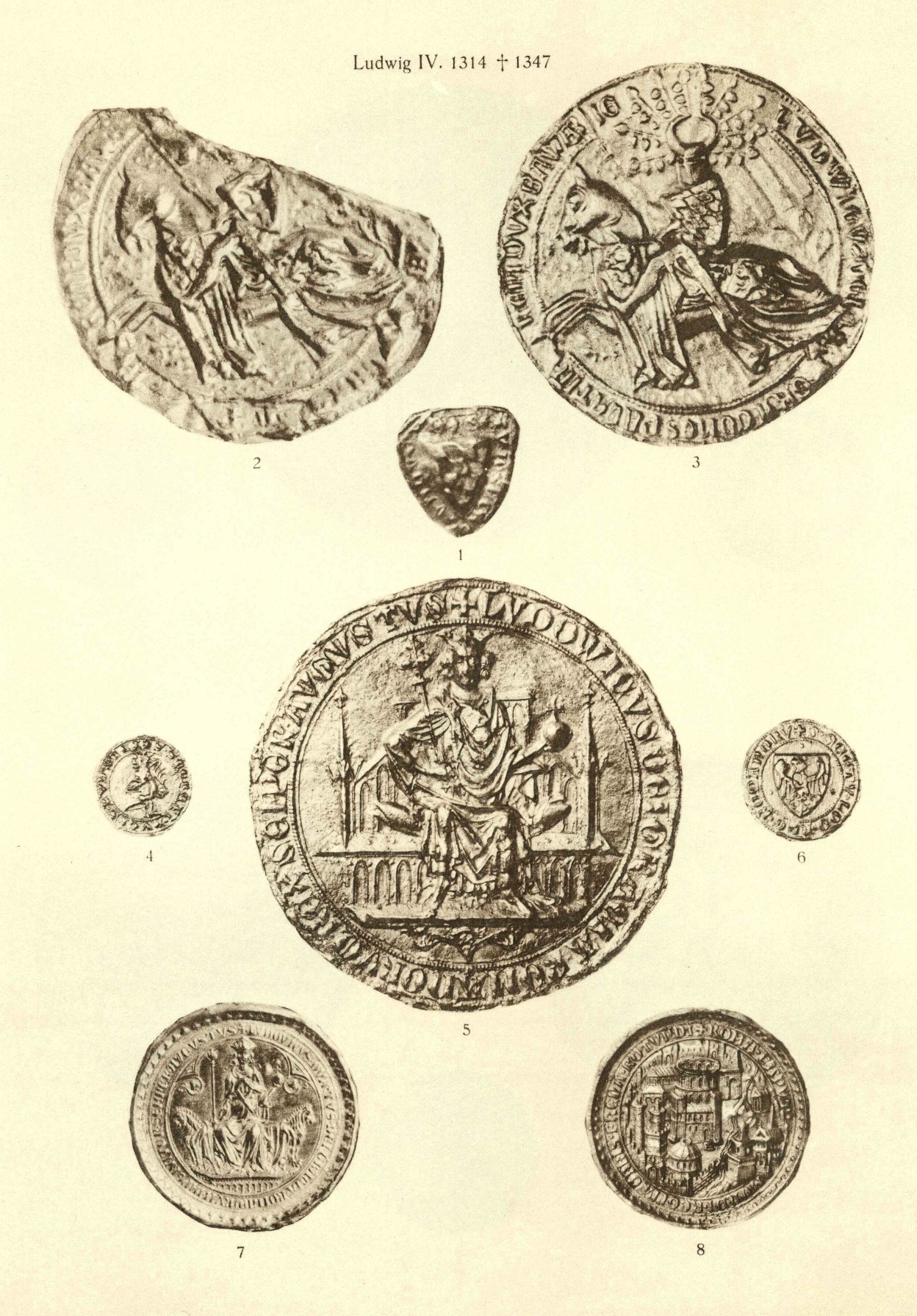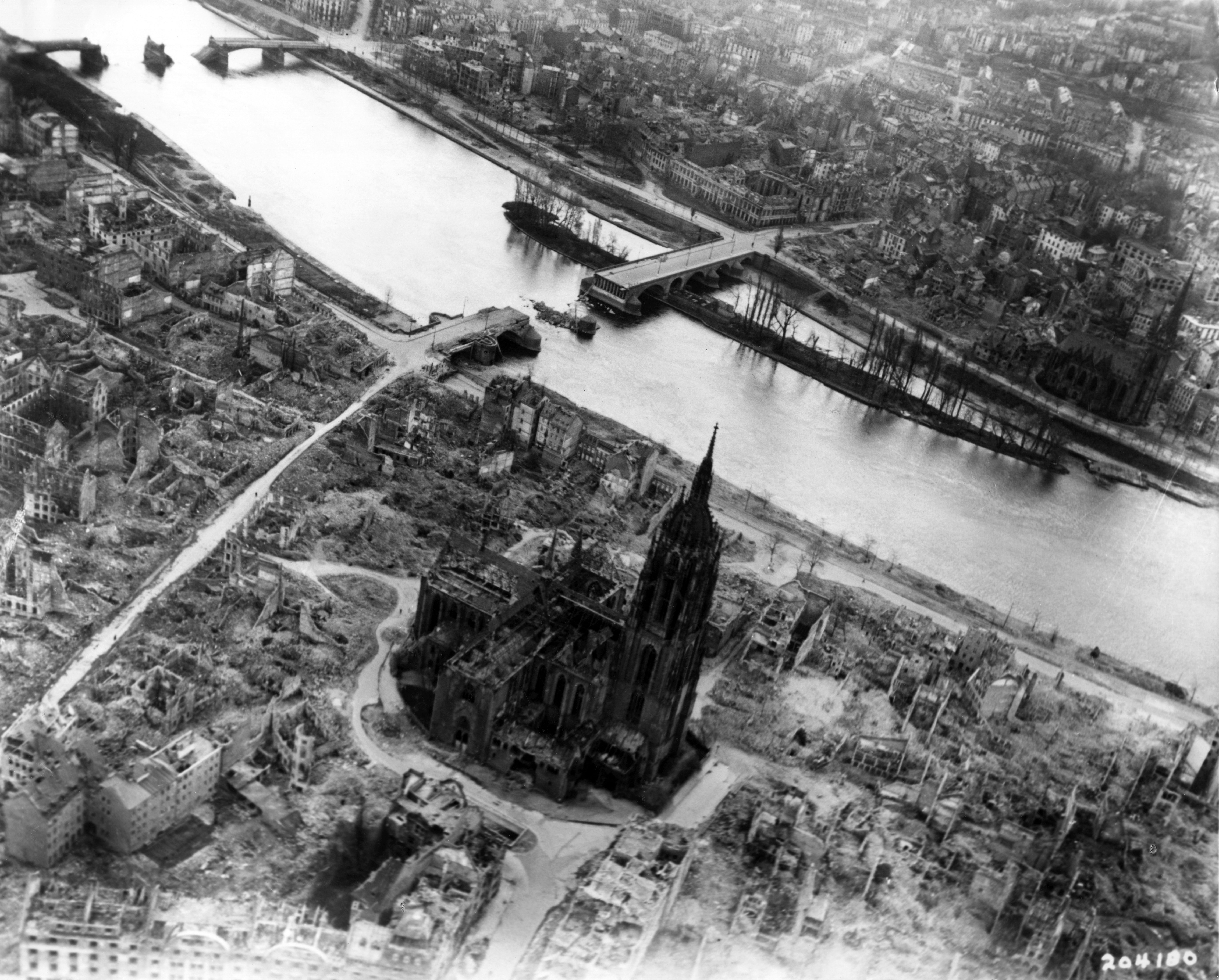|
Römer Nordbau, Frankfurt
The Römer (German surname, "Roman") is a medieval building in the Altstadt (Frankfurt am Main), Altstadt of Frankfurt am Main, Germany, and one of the city's most important landmarks. The Römer is located opposite the Old St. Nicholas Church and has been the city hall (''Rathaus'') of Frankfurt for over 600 years. The Römer merchant family sold it together with a second building, the ''Goldener Schwan'' (Golden Swan), to the city council on 11 March 1405 and it was converted for use as the city hall. The ''Haus Römer'' is actually the middle building of a set of three located in the ''Römerberg (Frankfurt), Römerberg'' plaza. The ''Römer'' is not a museum as it is occasionally used by the city for various purposes, for example as a ''Standesamt'' or civil registration office; the wedding rooms are located in the first and second floor of the ''Haus Löwenstein''. The former old town quarter between the Römer and Frankfurt Cathedral, St. Bartholomew's Cathedral has been ... [...More Info...] [...Related Items...] OR: [Wikipedia] [Google] [Baidu] |
Neogothic
Gothic Revival (also referred to as Victorian Gothic or neo-Gothic) is an architectural movement that after a gradual build-up beginning in the second half of the 17th century became a widespread movement in the first half of the 19th century, mostly in England. Increasingly serious and learned admirers sought to revive medieval Gothic architecture, intending to complement or even supersede the neoclassical styles prevalent at the time. Gothic Revival draws upon features of medieval examples, including decorative patterns, finials, lancet windows, and hood moulds. By the middle of the 19th century, Gothic Revival had become the pre-eminent architectural style in the Western world, only to begin to fall out of fashion in the 1880s and early 1890s. For some in England, the Gothic Revival movement had roots that were intertwined with philosophical movements associated with Catholicism and a re-awakening of high church or Anglo-Catholic belief concerned by the growth of religio ... [...More Info...] [...Related Items...] OR: [Wikipedia] [Google] [Baidu] |
Franz Adickes
Franz Bourchard Ernst Adickes was a German politician. He was the mayor of Dortmund from 1873 to 1876, the mayor of Altona from 1876 to 1879, and mayor of Frankfurt from 14 October 1890 to 1 October 1912. Adickes is considered one of the most important in the history of Frankfurt due to his tenure during the founding period, an important time in Frankfurt's urban development. In the history of Frankfurt, Adickes has the longest tenure as mayor. Family Adickes is the brother of German philosopher Erich Adickes. On 27 September 1873, Adickes married Sophie Therese Lambert (1848-1922) and they had four children: * Friedrich, the only son, died in July 1874 at the age of four days. * Theodore (1875-1945), married Dr. Ludwig Rottenberg (1864-1932), a Frankfurt composer and first conductor of the Frankfurt Opera in 1895. Her daughter, Gertrud (1900-1967) married the Frankfurt composer Paul Hindemith. * Gertrud (1878-1960), married the business magnate and politician Alfred Hu ... [...More Info...] [...Related Items...] OR: [Wikipedia] [Google] [Baidu] |
Louis IV, Holy Roman Emperor
Louis IV (; 1 April 1282 – 11 October 1347), called the Bavarian (, ), was King of the Romans from 1314, King of Italy from 1327, and Holy Roman Emperor from 1328 until his death in 1347. 20 October 1314 imperial election, Louis' election as king of Germany in 1314 was controversial, as his House of Habsburg, Habsburg cousin Frederick the Fair was simultaneously elected king by a separate set of electors. Louis defeated Frederick in the Battle of Mühldorf in 1322, and the two eventually reconciled. Louis was opposed and excommunicated by the French Pope John XXII; Louis in turn attempted to depose the pope and install an anti-pope. Louis IV was Duke of Upper Bavaria from 1294 to 1301 together with his elder brother Rudolf I, Duke of Bavaria, Rudolf I, was Margraviate of Brandenburg, Margrave of Brandenburg until 1323, and Electoral Palatinate, Count Palatine of the Rhine until 1329, and became Duke of Bavaria, Duke of Lower Bavaria in 1340. He was the last Bavarian to be a ... [...More Info...] [...Related Items...] OR: [Wikipedia] [Google] [Baidu] |
Frederick I, Holy Roman Emperor
Frederick Barbarossa (December 1122 – 10 June 1190), also known as Frederick I (; ), was the Holy Roman Emperor from 1155 until his death in 1190. He was elected King of Germany in Frankfurt am Main, Frankfurt on 4 March 1152 and crowned in Aachen on 9 March 1152. He was crowned King of Italy on 24 April 1155 in Pavia and emperor by Pope Adrian IV on 18 June 1155 in Rome. Two years later, the term ' ("holy") first appeared in a document in connection with his empire. He was later formally crowned King of Burgundy, at Arles on 30 June 1178. His nickname of ' (meaning "Red Beard" in Italian) "was first used by the Republic of Florence, Florentines only in 1298 to differentiate the emperor from his grandson, Frederick II, Holy Roman Emperor, Frederick II ... and was never employed in medieval Germany" (the colour red was "also associated in the Middle Ages with malice and a hot temper"; in reality, Frederick's hair was "blond", although his beard was described by a contemporar ... [...More Info...] [...Related Items...] OR: [Wikipedia] [Google] [Baidu] |
Holy Roman Empire
The Holy Roman Empire, also known as the Holy Roman Empire of the German Nation after 1512, was a polity in Central and Western Europe, usually headed by the Holy Roman Emperor. It developed in the Early Middle Ages, and lasted for a millennium until its Dissolution of the Holy Roman Empire, dissolution in 1806 during the Napoleonic Wars. For most of its history the Empire comprised the entirety of the modern countries of Germany, Czechia, Austria, the Netherlands, Belgium, Switzerland, Slovenia, and Luxembourg, most of north-central Italy, and large parts of modern-day east France and west Poland. On 25 December 800, Pope Leo III crowned the Frankish king Charlemagne Roman emperor, reviving the title more than three centuries after the fall of the Western Roman Empire in 476. The title lapsed in 924, but was revived in 962 when Otto I, OttoI was crowned emperor by Pope John XII, as Charlemagne's and the Carolingian Empire's successor. From 962 until the 12th century, the empire ... [...More Info...] [...Related Items...] OR: [Wikipedia] [Google] [Baidu] |
Kaiser
Kaiser ( ; ) is the title historically used by German and Austrian emperors. In German, the title in principle applies to rulers anywhere in the world above the rank of king (). In English, the word ''kaiser'' is mainly applied to the emperors of the unified German Empire (1871–1918) and the emperors of the Austrian Empire (1804–1918). During the First World War, anti-German sentiment was at its zenith; the term ''kaiser''—especially as applied to Wilhelm II, German Emperor—thus gained considerable negative connotations in English-speaking countries. Especially in Central Europe, between northern Italy and southern Poland, between western Austria and western Ukraine and in Bavaria, Emperor Franz Joseph I is still associated with (the emperor) today. As a result of his long reign from 1848 to 1916 and the associated Golden Age before the First World War, this title often has still a very high historical respect in this geographical area. Etymology and language usage ... [...More Info...] [...Related Items...] OR: [Wikipedia] [Google] [Baidu] |
Frankfurt Am Main-Roemer-Roemerhalle-1553
Frankfurt am Main () is the most populous city in the German state of Hesse. Its 773,068 inhabitants as of 2022 make it the fifth-most populous city in Germany. Located in the foreland of the Taunus on its namesake Main, it forms a continuous conurbation with Offenbach am Main; its urban area has a population of over 2.7 million. The city is the heart of the larger Rhine-Main metropolitan region, which has a population of more than 5.8 million and is Germany's second-largest metropolitan region after the Rhine-Ruhr region and the fourth largest metropolitan region by GDP in the European Union (EU). Frankfurt is one of the '' de facto'' four main capitals of the European Union (alongside Brussels, Luxembourg and Strasbourg), as it is home to the European Central Bank, one of the institutional seats of the European Union, while Frankfurt's central business district lies about northwest of the geographic center of the EU at Gadheim in Lower Franconia. Like France ... [...More Info...] [...Related Items...] OR: [Wikipedia] [Google] [Baidu] |
Wall Relief City Arms Frankfurt Hesse Germany
A wall is a structure and a surface that defines an area; carries a load; provides security, shelter, or soundproofing; or serves a decorative purpose. There are various types of walls, including border barriers between countries, brick walls, defensive walls in fortifications, and retaining walls that hold back dirt, stone, water, or noise. Walls can also be found in buildings, where they support roofs, floors, and ceilings, enclose spaces, and provide shelter and security. The construction of walls can be categorized into framed walls and mass-walls. Framed walls transfer the load to the foundation through posts, columns, or studs and typically consist of structural elements, insulation, and finish elements. Mass-walls are made of solid materials such as masonry, concrete, adobe, or rammed earth. Walls may also house utilities like electrical wiring or plumbing and must conform to local building and fire codes. Walls have historically served defensive purposes, with the ... [...More Info...] [...Related Items...] OR: [Wikipedia] [Google] [Baidu] |
Theodor Heuss
Theodor Heuss (; 31 January 1884 – 12 December 1963) was a German liberal politician who served as the first president of West Germany from 1949 to 1959. His civil demeanour and his cordial nature – something of a contrast to German nationalist traditions and the stern character of chancellor Konrad Adenauer – largely contributed to the stabilization of democracy in West Germany during the '' Wirtschaftswunder'' years. Before beginning his career as a politician, Heuss had been a political journalist. To this day, Heuss is remembered as a major representative of social liberalism in Germany. Early life and education Heuss was born in Brackenheim, a small town and wine-making community near Heilbronn in Württemberg, on the border between the historic regions of Swabia and Franconia. He attended the Karlsgymnasium in Heilbronn, from which he graduated in 1902. This selective secondary school has since been renamed the Theodor-Heuss-Gymnasium, in honor of its ... [...More Info...] [...Related Items...] OR: [Wikipedia] [Google] [Baidu] |
Second World War
World War II or the Second World War (1 September 1939 – 2 September 1945) was a World war, global conflict between two coalitions: the Allies of World War II, Allies and the Axis powers. World War II by country, Nearly all of the world's countries participated, with many nations mobilising all resources in pursuit of total war. Tanks in World War II, Tanks and Air warfare of World War II, aircraft played major roles, enabling the strategic bombing of cities and delivery of the Atomic bombings of Hiroshima and Nagasaki, first and only nuclear weapons ever used in war. World War II is the List of wars by death toll, deadliest conflict in history, causing World War II casualties, the death of 70 to 85 million people, more than half of whom were civilians. Millions died in genocides, including the Holocaust, and by massacres, starvation, and disease. After the Allied victory, Allied-occupied Germany, Germany, Allied-occupied Austria, Austria, Occupation of Japan, Japan, a ... [...More Info...] [...Related Items...] OR: [Wikipedia] [Google] [Baidu] |
Bombing Of Frankfurt Am Main In World War II
Bombing of Frankfurt am Main by the Allies of World War II killed about 5,500 residents and destroyed the largest half-timbered historical city centre in Germany (the Eighth Air Force dropped 12,197 tons of explosives on the city Bombing the European Axis Powers -->). In the 1939–45 period the Royal Air Force (RAF) dropped of bombs on Frankfurt. Post-war reconstruction of Frankfurt, Post-war reconstruction generally used modern architecture, and a few landmark buildings were rebuilt in a simple historical style. The 1st building rebuilt was the 1789 St. Paul's Church, Frankfurt, Paulskirche (''St. Paul's Church''). See also * Post-war reconstruction of Frankfurt References Further reading * * * * * External links {{WWII city bombing Frankfurt in World War II World War II strategic bombing of Germany, Frankfurt World War II strategic bombing lists World War II strategic bombing by populated place, Frankfurt Germany–United Kingdom military relations Germa ... [...More Info...] [...Related Items...] OR: [Wikipedia] [Google] [Baidu] |








